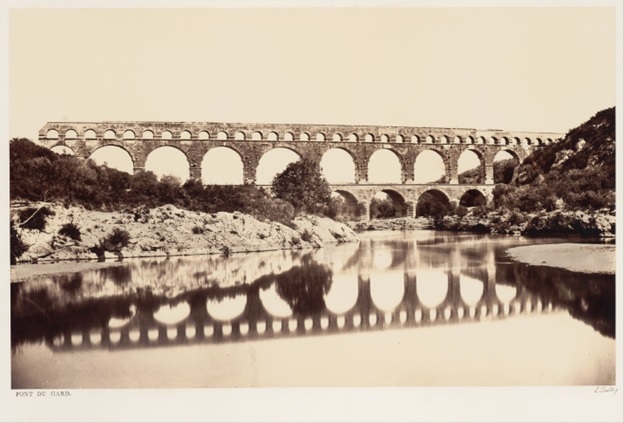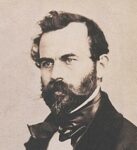
Édouard-Denis Baldus
French, 1813–1889
Pont du Gard, 1861 ca.
albumen silver print
7 3/4 × 11 1/8 in.
SBMA, Gift of Mr. and Mrs. Kingman Douglass
1992.6.1

Édouard-Denis Baldus - undated photo
COMMENTS
Twenty-five-year-old Édouard Baldus arrived in Paris to study painting in 1838, shortly before Louis Daguerre first showed his magically precise photographic images to the world. In Paris, the self-taught Baldus worked outside the École des Beaux-Arts and atelier system, but submitted work to each of the annual Salons of painting and sculpture in Paris from 1841 to 1851. As a painter he met with little success and achieved no critical mention, but in the decade that followed, from 1851 to 1861, Baldus abandoned the easel and took up the camera, rose to the top of his new profession, won international critical acclaim, secured commissions from government ministries and captains of industry, and created a body of photographs now considered early masterpieces of the art.
Baldus first experimented with photography in the late 1840s, when the negative-positive process for paper photographs, invented by the Englishman William Henry Fox Talbot, began to flourish in France. By 1851, he was recognized as one of the few photographers to combine aesthetic sensitivity with an astonishing technical prowess in the still experimental and handcrafted medium. In that year he was one of five artists selected by the Commission des Monuments Historiques, a government agency, to carry out Missions Héliographiques, photographic surveys of the nation’s architectural patrimony, focusing particularly on those monuments in need of restoration. Baldus was sent south, to Fontainebleau, through Burgundy, the Dauphiné and Lyonnais, Provence, and a small part of Languedoc.
So impressive were Baldus’ pictures from the standpoint of clarity, beauty, and scale (some, printed from multiple negatives, reached three feet in length), that he quickly won government support for a project entitled "Les Villes de France photographiées", an extended series of architectural views in Paris and the provinces designed to feed a resurgent interest in the nation’s Roman and medieval past. After focusing on the chief monuments of the French capital in 1852, Baldus traveled again to the south of France in the autumn of 1853, approaching his subjects with a rigor that banished precisely those picturesque elements and anecdotal details traditionally considered necessary to animate topographic prints of the period.
The following summer, Baldus coursed the dirt roads of the countryside by horse-drawn cart, moving from ruined castle to thatched hut, from pilgrimage church to paper mill, from town square to wooded chasm, through the fertile lowlands and rugged mountains of the Auvergne, in central France. Perhaps owing to the different physical character of this region, Baldus made photographs of the land itself, adding a poetic force to the graphic power and documentary value of his earlier photographs.
By 1855, Baldus had established a reputation as the leading architectural photographer in France, and his pictures drew much public attention and critical notice at the 1855 Exposition Universelle in Paris. In August of that year, Baron James de Rothschild—banker, industrialist, and president of the Chemin de fer du Nord (Northern Railway)—commissioned Baldus to produce an album of the highest quality. Showing views along the rail route from Paris to Boulogne-sur-Mer, the album was intended as a gift for Queen Victoria, a souvenir of her passage on the line during her state visit to Paris. The lavishly bound album is still among the treasures of the Royal Library at Windsor Castle, and the beautifully composed and richly printed photographs of cathedrals, town, and railroad installations included in it are among the photographer’s finest. They embody a classic, objectified vision softened by lessons learned in the landscapes of the Auvergne, and an equilibrium of documentation and artistry, of descriptive directness and picturesqueness, of presenting the scene to the viewer and inviting the viewer into the scene.
Also in 1855, Baldus began photographing on the work site of the New Louvre, documenting for architect Hector Lefuel every piece of statuary and ornamentation made for the vast complex linking the Louvre and Tuileries palaces. As individual records, these photographs served a practical function on the bustling work site, keeping track of the hundreds of plaster models and carved stones sculpted for the project; but as a collected whole, they formed a new means of comprehending and communicating a complex subject, bit by bit, to be reconstituted by the mind. Only photography—precise, omnivorous, prolific, and rapid—and then only in the hands of an artist both sensitive and rigorous—could produce an archive as a new form of art. Baldus’ photographs of the grandest of Napoleon III’s building projects were assembled in albums (four volumes in each set) and presented by the emperor to government ministers, the imperial family, and the reigning monarchs of Europe.
In June 1856, in the midst of his work at the Louvre, Baldus set out on a brief assignment, equally without precedent in photography, that was in many ways its opposite: to photograph the destruction caused by torrential rains and overflowing rivers in Lyon, Avignon, and Tarascon. From a world of magnificent man-made construction, he set out for territory devastated by natural disaster; from the task of re-creating the whole of a building in a catalogue of its thousand parts, he turned to the challenge of evoking a thousand individual stories in a handful of transcendent images. Baldus created a moving record of the flood without explicitly depicting the human suffering left in its wake. The “poor people, tears in their eyes, scavenging to find the objects most indispensable to their daily needs,” described by the local "Courier de Lyon", are all but absent from his photographs of the hard-hit Brotteaux quarter of Lyon, as if the destruction had been of biblical proportions, leaving behind only remnants of a destroyed civilization.
In the years that followed, Baldus expanded his highly successful series of large-format views of historic monuments, in both Paris and the provinces, and around 1860 he photographed the rough alpine regions of southeastern France. But it was in the second of his two railway albums, commissioned in 1861 by the Chemins de fer de Paris à Lyon et à la Méditerranée, that Baldus again pioneered new aesthetic ground and drew from a decade’s work to speak forcefully and eloquently about the relationship of history and progress. The album is a masterfully composed sequence of sixty-nine photographs of the landscape, towns, principal sites of interest, and railroad structures along the line from Lyon to Marseille and Toulon. By interspersing boldly geometric images of the railroad tracks, stations, tunnels, and viaducts with his classic views of historic architecture—the ramparts of Avignon, the Maison Carrée, Saint-Trophîme, the Pont du Gard—Baldus presented Second Empire engineers as the natural heirs to a great tradition of building that stretched back to Roman and medieval times.
The final section of the album presents the natural beauty of the Côte d’Azur, including the majestic rock formations at La Ciotat. The concluding pair of images restate the album’s central theme of progress: wilderness and civilization—Nature and Man—are juxtaposed. The rocky Ollioules Gorge is barren and untamed, walled in by cliffs at left and right (an effect emphasized by the dark edges of the photograph). Turn the page and one is in a different world: at the railroad station of Toulon, there is a Cartesian order to the arrangement of space and structures; the materials are iron and glass, dressed stone and brick; everything is crisp, industrial, modern. Most dramatically, the tracks race straight back through the station, as if pointing toward Nice and the Italian frontier (lines already viewed as the logical extension of the rail network)–and toward the future.
The photographs of Édouard Baldus are inextricably linked to the principal ideas of his age. Beginning with the Mission Héliographique, his views of historic monuments presented the vestiges of the past with unromanticized clarity for the architect, archaeologist, historian, and armchair traveler. His photographs of the construction of the New Louvre celebrated the glory of the Second Empire and created an art of the archive. And his presentation of a landscape transformed by modern engineering confidently espoused a belief in technological progress. In ten years, Baldus established the model for photographic representation in genres that barely existed before him.
https://www.metmuseum.org/toah/hd/bald/hd_bald.htm
SBMA CURATORIAL LABELS
Born in Prussia (now Germany), the aspiring painter Edouard-Denis Baldus moved to Paris just before the invention of photography was announced in Paris in 1839. Seizing on the new medium’s artistic and commercial possibilities, he became one of Europe’s most successful photographic practitioners. Hired by the French government, Baldus expertly captured scenes of urban and rural France, including evidence of France’s Roman past as seen here. Of note in these four ingeniously composed photographs is the mesmerizing vision of a Roman bridge (the Pont du Gard) reflected in water as if in a dream. Another is the view of a triumphal arch in Paris that could almost be an opera set. Created under Napoleon Bonaparte in the early 19"‘ century, the Arc de Triomphe du Carrousel mimicked the grandeur of ancient Roman arches to create a propagandistic aura of timeless legitimacy to Napoleon's imperialist campaigns and goals for even greater power.
- Greco-Roman, 2022
